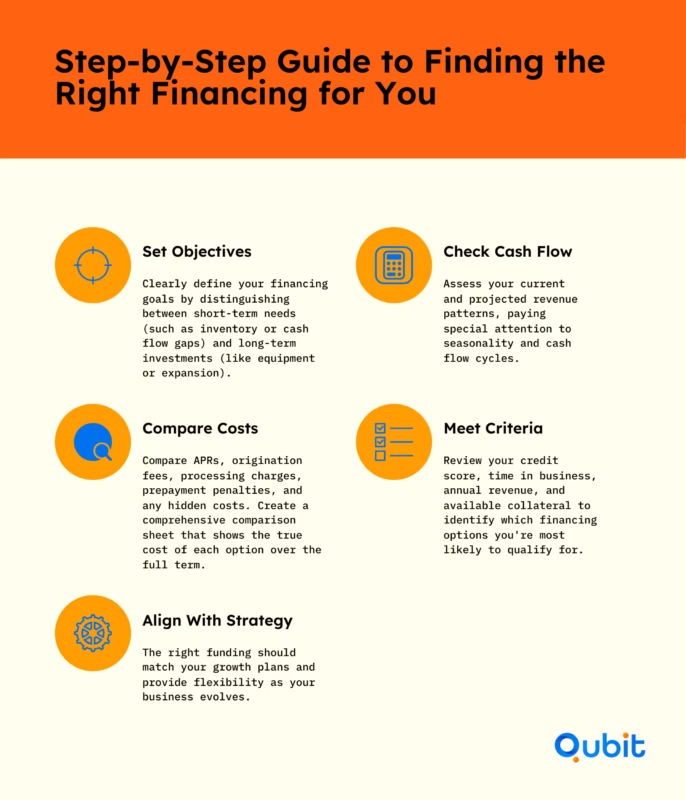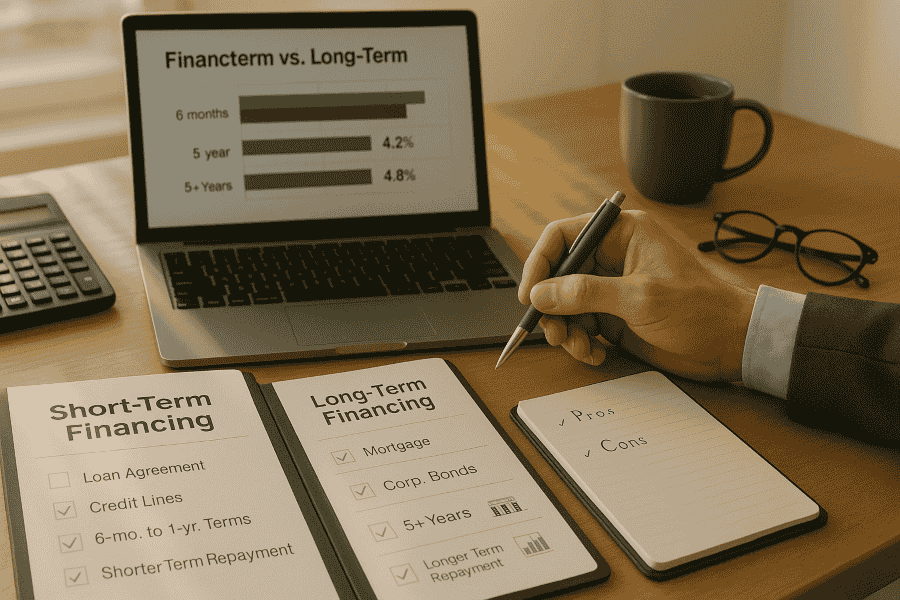The funding path you choose doesn’t just affect your cash flow—it can shape the future of your business. Whether you're covering next month's payroll or planning five years ahead, the way you finance those needs matters. Short-term financing is often the go-to when speed is key, while long-term solutions are built for founders playing the long game.
Knowing where these options sit within the broader world of types of startup funding can help you spot the strategy that fits—not just your balance sheet, but your vision.
In this article, we’ll break it all down—no jargon, no fluff—so you can make confident, informed decisions about how to fund your next move.
Find the Best Financing Balance for Your Short- and Long-Term Goals
Balancing short-term and long-term financing is a critical decision for businesses aiming to meet immediate needs while planning for sustained growth. Each option offers distinct advantages, and understanding their trade-offs can help you align funding strategies with your goals.
Short-Term Financing: Speed Meets Flexibility
Short-term financing is designed to address immediate liquidity needs, such as bridging cash flow gaps or covering unexpected expenses. One of its standout features is rapid approval speed. For example, Bank Loan Approval Speed research shows that up to 39% of small business loans can be approved within one business day. This makes short-term financing highly accessible for businesses requiring quick capital injections.
However, this convenience often comes with higher annual percentage rates (APRs). While short-term loans are ideal for operational needs, businesses must weigh the cost of higher interest rates against the urgency of their funding requirements.
Long-Term Financing: Stability for Strategic Growth
Long-term financing, on the other hand, provides extended repayment periods and lower interest rates, making it a better fit for large-scale investments like purchasing equipment or expanding operations. According to SBA Stats, loans can reach up to $5 million with interest rates ranging from 5% to 10%. These favorable terms allow businesses to plan for growth without the pressure of immediate repayment.
While long-term financing offers stability, it often involves a more rigorous approval process, which can take weeks or even months. This makes it less suitable for addressing urgent financial needs but invaluable for strategic, long-term planning.
Comparing Short-Term vs Long-Term Financing
Understanding the differences between short-term and long-term financing is essential for making informed decisions:
- Approval Speed: Short-term financing is faster, with approvals often completed within a day. Long-term financing requires more time due to detailed evaluations.
- Interest Rates: Short-term loans typically have higher APRs, while long-term loans offer lower rates.
- Purpose: Short-term financing is ideal for operational needs, whereas long-term financing supports capital investments and strategic growth.
Data-Driven Insights for Smarter Choices
The choice between short-term and long-term financing should be guided by your business’s immediate needs and future objectives. For example, if your priority is addressing cash flow gaps quickly, short-term financing may be the better option despite higher interest rates. Conversely, if your focus is on scaling operations, long-term financing provides the stability and affordability required for major investments.
By evaluating these trade-offs, businesses can create a balanced financing strategy that supports both short-term operations and long-term growth.
CTA: Explore tailored financing solutions with Qubit Capital to find the perfect balance for your business goals.
Step-by-Step Guide to Finding the Right Financing for You
Securing the right financing can be a pivotal moment for any business. Whether you’re a startup or an established company, aligning your funding choice with your objectives is essential for sustainable growth. This guide outlines a five-step process to help you evaluate and select the financing option that best fits your needs.

1. Define Your Business Objectives
Start by identifying the purpose of the financing. Are you looking to cover short-term expenses, such as inventory purchases, or are you planning for long-term investments like equipment upgrades? Understanding your goals will help you determine whether short-term vs long-term financing is more suitable. Short-term financing is ideal for immediate needs, while long-term options are better suited for strategic growth initiatives.
2. Analyze Your Cash Flow
A clear picture of your cash flow is crucial when choosing financing. Assess your revenue patterns, expenses, and any seasonal fluctuations. This analysis will help you determine how much you can afford to borrow and repay without straining your operations. For example, businesses with irregular cash flow might benefit from flexible repayment terms, while those with steady income can opt for fixed repayment schedules.
3. Understand Cost Implications
Every financing option comes with costs, including interest rates, fees, and potential penalties. Compare the total cost of borrowing for both short-term and long-term financing options. Short-term loans often have higher interest rates but lower overall costs due to shorter repayment periods. Long-term loans, while offering lower monthly payments, may result in higher cumulative costs over time.
4. Evaluate Qualification Criteria
Different financing options have varying qualification requirements. Traditional bank loans often demand strong credit scores and detailed financial statements, while alternative lenders may focus on cash flow and business performance. Preparing financial statements for lenders ensures that your startup presents a clear and compelling financial picture, which is critical for securing both short-term and long-term financing.
5. Match Financing to Growth Strategy
Finally, align your financing choice with your business growth strategy. If your goal is rapid expansion, consider options that provide immediate access to capital. For steady growth, long-term financing may be more appropriate. By choosing the right option, you can avoid misalignment of funds and ensure your financial decisions support sustainable growth.
Selecting the right financing doesn’t have to be overwhelming. By following this structured approach, you can make informed decisions that align with your business objectives and financial health.
Find Funding Providers That Fit Your Business Needs
Securing the right financing for your business requires more than just finding a lender—it’s about identifying providers whose solutions align with your operational goals. Leading funding providers offer tailored options that address both immediate liquidity needs and long-term financing strategies, ensuring businesses can thrive in dynamic markets.
Short-Term Financing for Immediate Cash Flow
Short-term financing solutions are essential for businesses facing urgent cash flow challenges. Viva Capital’s invoice factoring services exemplify this approach, enabling entrepreneurs to convert outstanding invoices into immediate funds. For instance, R. Ramirez utilized Viva Capital’s lower-rate factoring plan to save $5,000 in interest while maintaining steady cash flow. This case highlights how customized short-term financing can reduce costs and provide operational stability.
If you’re weighing the benefits and risks of borrowing, understanding the pros and cons of debt financing is crucial. This analysis can help determine whether short-term funding aligns with your immediate needs.
Long-Term Financing for Sustainable Growth
For businesses aiming to scale, long-term financing options provide the stability needed to support expansion. ScotPac’s flexible lines of credit and trade finance solutions are a prime example. BelCon Logistics, a startup in the logistics sector, leveraged ScotPac’s offerings to fund operational surges, achieving a remarkable 1,000% turnover growth. This demonstrates how long-term financing can empower businesses to seize growth opportunities without compromising financial health.
Tailored Solutions for Diverse Needs
Every business has unique financial requirements, and leading providers like Viva Capital and ScotPac excel at delivering customized solutions. Whether it’s invoice factoring for immediate liquidity or trade finance for sustained growth, these providers showcase how tailored lending products can address specific challenges while fostering long-term success.
Finding the right funding provider is about more than just securing capital—it’s about ensuring the solution fits your business model and growth trajectory. By exploring case studies like those of R. Ramirez and BelCon Logistics, businesses can better understand how financing options can be strategically applied to achieve their goals.
CTA: Need assistance identifying the best funding solutions for your business? Contact us today to explore tailored financing options that drive growth and stability.
Customized Financing Solutions for Your Industry
Every industry operates within unique financial frameworks, requiring tailored solutions to address their specific needs. From managing liquidity gaps to funding long-term growth initiatives, businesses must balance short-term vs long-term financing strategies to optimize their operations.
Short-Term Financing for Immediate Needs
Short-term financing options are often critical for industries with fluctuating cash flow cycles or immediate liquidity demands. For instance, startups like Cold Way have successfully utilized invoice financing to bridge cash flow gaps. This approach enabled the company to increase revenue by 47% within its first year, showcasing the swift ROI potential of short-term funding solutions. Similarly, small businesses such as Sun City have demonstrated how accessible capital can ignite rapid expansion, quadrupling their revenue through fast-deployed funding.
Long-Term Financing for Strategic Growth
On the other hand, industries with high capital intensity often rely on long-term financing to support strategic investments. Manufacturing firms, for example, benefit from asset-based lending to enhance production capacity while maintaining liquidity.
Industry-Specific Approaches
Tailored financial strategies are essential for optimizing the cost of capital across diverse sectors. For instance, Green Valley Healthcare, a multi-specialty clinic, faced cash flow challenges due to delayed insurance reimbursements. By partnering with a healthcare factoring firm, they received up to 90% of their invoice values upfront, enabling them to stabilize operations and continue providing quality care.
Customized financing solutions empower businesses to align their funding strategies with industry-specific demands, ensuring both immediate operational efficiency and long-term growth.
Conclusion
Choosing between short-term and long-term financing requires a clear understanding of your business's unique goals and financial landscape. While short-term financing offers flexibility for immediate needs, long-term financing provides stability for sustained growth. The key lies in aligning your financing strategy with your specific objectives, ensuring that each decision supports your broader vision.
Proactively assessing your financial requirements is essential to maintaining a healthy cash flow and driving sustainable growth. By evaluating factors such as repayment terms, interest rates, and the purpose of the funds, businesses can craft a tailored approach that minimizes risks and maximizes opportunities.
If you're ready to optimize your capital strategy, we at Qubit Capital invite you to explore our Financial Model Creation service. Let us help you build robust forecasts and empower your business to achieve its growth potential.
Key Takeaways
Different financing options cater to distinct business needs and growth stages.
Short-term financing offers rapid capital access with potentially higher costs, while long-term financing provides stability through lower interest rates.
A systematic evaluation of funding objectives, cash flow, and eligibility is essential for making informed decisions.
Industry-specific strategies ensure that financing solutions are tailored to operational realities.
Leveraging data-driven insights and actionable case studies can optimize overall cost of capital and support sustainable expansion.
Frequently asked Questions
Which is better, short-term or long-term financing?
Both financing options serve unique purposes. Short-term financing is ideal for immediate needs, offering quick access to funds, while long-term financing provides stability and lower interest rates for larger, extended investments.


 Back
Back



